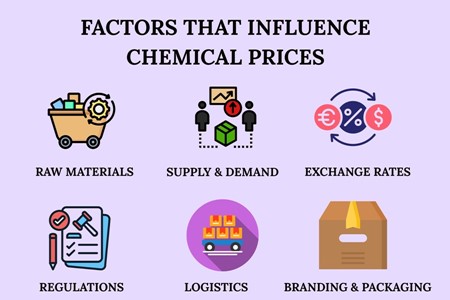
The chemical industry, being one of the most complex and dynamic sectors, experiences constant shifts in pricing due to various internal and external factors. Whether you are a manufacturer, distributor, or end-user, understanding the key drivers behind chemical pricing is essential for strategic decision-making, budgeting, and long-term planning. In this blog, we explore the core factors that influence the pricing of chemicals in the market.
1. Raw Material Costs
The foundation of chemical pricing starts with the cost of raw materials. These inputs, often derived from petroleum, minerals, or agricultural sources, fluctuate based on global supply and demand. For instance:
-
Crude oil and natural gas prices directly affect petrochemical costs.
-
Availability of minerals like phosphorus or rare earth elements impacts specialty chemicals.
Even slight changes in raw material prices can cause ripple effects across the pricing of downstream chemicals.
2. Supply and Demand Dynamics
Like any other commodity, chemical prices are heavily influenced by supply and demand trends:
-
Oversupply due to overproduction or slow market demand can push prices down.
-
Shortages caused by production outages, geopolitical issues, or natural disasters often lead to price surges.
Emerging industries (e.g., EVs, clean tech) can also create sudden spikes in demand for certain chemicals.
3. Energy and Utility Costs
Chemical manufacturing is energy-intensive. Electricity, steam, water, and other utilities are critical to processes like distillation, crystallization, and drying. Rising fuel or energy prices can significantly impact the cost of production, especially for bulk and inorganic chemicals.
4. Regulatory and Compliance Costs
Adhering to environmental and safety regulations—such as REACH (EU), EPA (USA), or BIS (India)—can add to the cost of compliance. This includes expenses for:
-
Product testing and certification
-
Waste management and effluent treatment
-
Safety and hazard labeling
Export-oriented manufacturers also incur additional documentation and compliance costs.
5. Transportation and Logistics
Chemicals require careful handling, storage, and transportation, often involving special packaging (like HDPE drums or IBC tanks) and safety protocols. Factors impacting logistics costs include:
-
Global freight rates and container availability
-
Fuel prices and local transportation taxes
-
Import/export tariffs or duties
Delays in supply chains can further escalate costs.
6. Currency Exchange Rates
For companies involved in international trade, currency volatility plays a crucial role. A weakening local currency can increase the landed cost of imported raw materials or finished chemicals, thereby influencing selling prices.
7. Product Grade and Purity
Chemicals are sold in various grades—technical, industrial, laboratory reagent (LR), analytical reagent (AR), and pharma grade. Higher-purity grades undergo more refining and testing, hence priced at a premium. End-use applications often determine the suitable grade and thus affect pricing.
8. Packaging and Branding
Custom or premium packaging, private labelling, and strong brand value can allow companies to charge higher prices. In sectors where quality perception is critical (e.g., pharmaceuticals, cosmetics), well-known chemical brands command trust—and better margins.
9. Market Competition
The number of suppliers in the market also impacts pricing. In highly competitive segments, prices remain under pressure, while niche or patented chemicals may enjoy monopoly or oligopoly pricing due to limited alternatives.
10. Innovations and Value-Added Services
Value-added offerings like customized blends, pre-weighed packs, technical support, or inventory management can enhance the perceived value of a product. Innovative solutions or eco-friendly alternatives also often justify higher prices.
Conclusion
Chemical pricing is a multi-layered equation, influenced by macroeconomic forces, operational realities, and customer expectations. Manufacturers and buyers alike must keep a close watch on these key factors to stay agile and competitive. With transparency, adaptability, and strategic sourcing, navigating the complexities of chemical pricing becomes significantly easier.